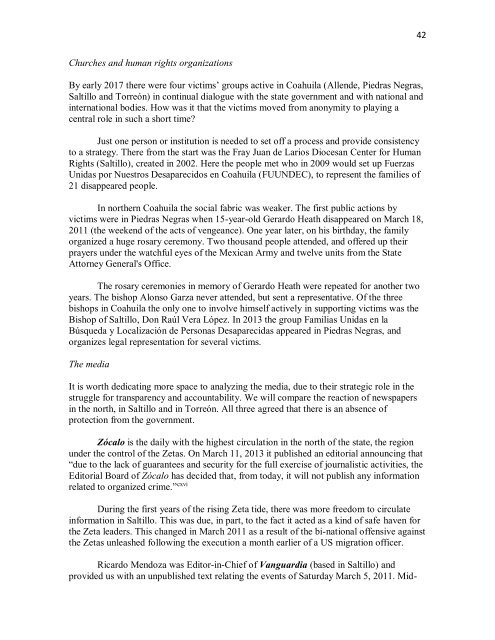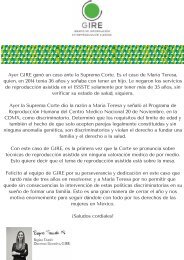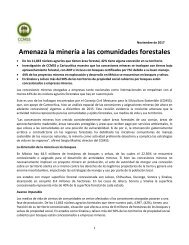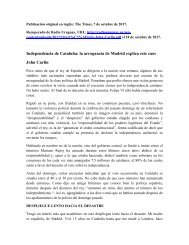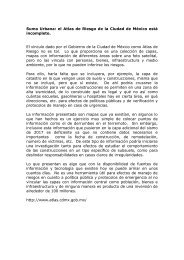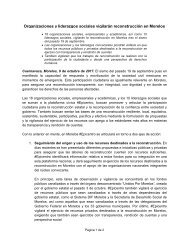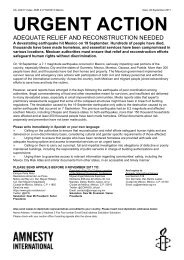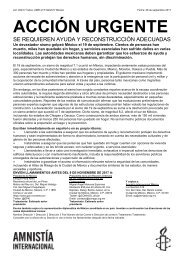You also want an ePaper? Increase the reach of your titles
YUMPU automatically turns print PDFs into web optimized ePapers that Google loves.
42<br />
Churches and human rights organizations<br />
By early 2017 there were four victims’ groups active in Coahuila (Allende, Piedras Negras,<br />
Saltillo and Torreón) in continual dialogue with the state government and with national and<br />
international bodies. How was it that the victims moved from anonymity to playing a<br />
central role in such a short time?<br />
Just one person or institution is needed to set off a process and provide consistency<br />
to a strategy. There from the start was the Fray Juan de Larios Diocesan Center for Human<br />
Rights (Saltillo), created in 2002. Here the people met who in 2009 would set up Fuerzas<br />
Unidas por Nuestros Desaparecidos en Coahuila (FUUNDEC), to represent the families of<br />
21 disappeared people.<br />
In northern Coahuila the social fabric was weaker. The first public actions by<br />
victims were in Piedras Negras when 15-year-old Gerardo Heath disappeared on March 18,<br />
2011 (the weekend of the acts of vengeance). One year later, on his birthday, the family<br />
organized a huge rosary ceremony. Two thousand people attended, and offered up their<br />
prayers under the watchful eyes of the Mexican Army and twelve units from the State<br />
Attorney General's Office.<br />
The rosary ceremonies in memory of Gerardo Heath were repeated for another two<br />
years. The bishop Alonso Garza never attended, but sent a representative. Of the three<br />
bishops in Coahuila the only one to involve himself actively in supporting victims was the<br />
Bishop of Saltillo, Don Raúl Vera López. In 2013 the group Familias Unidas en la<br />
Búsqueda y Localización de Personas Desaparecidas appeared in Piedras Negras, and<br />
organizes legal representation for several victims.<br />
The media<br />
It is worth dedicating more space to analyzing the media, due to their strategic role in the<br />
struggle for transparency and accountability. We will compare the reaction of newspapers<br />
in the north, in Saltillo and in Torreón. All three agreed that there is an absence of<br />
protection from the government.<br />
Zócalo is the daily with the highest circulation in the north of the state, the region<br />
under the control of the Zetas. On March 11, 2013 it published an editorial announcing that<br />
“due to the lack of guarantees and security for the full exercise of journalistic activities, the<br />
Editorial Board of Zócalo has decided that, from today, it will not publish any information<br />
related to organized crime.” cxvi<br />
During the first years of the rising Zeta tide, there was more freedom to circulate<br />
information in Saltillo. This was due, in part, to the fact it acted as a kind of safe haven for<br />
the Zeta leaders. This changed in March 2011 as a result of the bi-national offensive against<br />
the Zetas unleashed following the execution a month earlier of a US migration officer.<br />
Ricardo Mendoza was Editor-in-Chief of Vanguardia (based in Saltillo) and<br />
provided us with an unpublished text relating the events of Saturday March 5, 2011. Mid-


